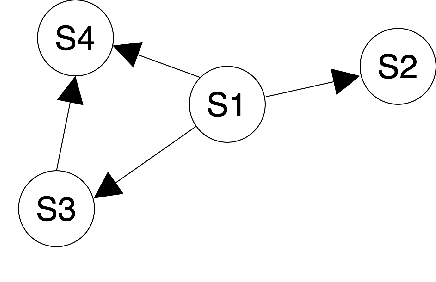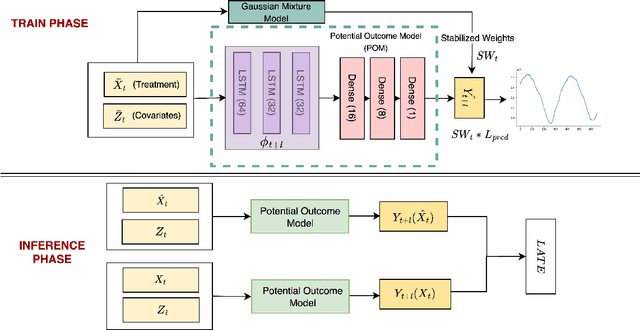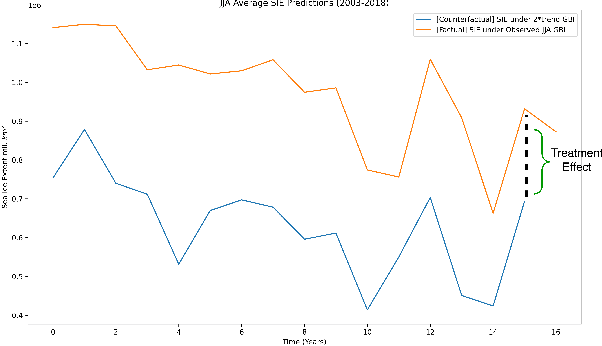Sahara Ali
Estimating Direct and Indirect Causal Effects of Spatiotemporal Interventions in Presence of Spatial Interference
May 13, 2024Abstract:Spatial interference (SI) occurs when the treatment at one location affects the outcomes at other locations. Accounting for spatial interference in spatiotemporal settings poses further challenges as interference violates the stable unit treatment value assumption, making it infeasible for standard causal inference methods to quantify the effects of time-varying treatment at spatially varying outcomes. In this paper, we first formalize the concept of spatial interference in case of time-varying treatment assignments by extending the potential outcome framework under the assumption of no unmeasured confounding. We then propose our deep learning based potential outcome model for spatiotemporal causal inference. We utilize latent factor modeling to reduce the bias due to time-varying confounding while leveraging the power of U-Net architecture to capture global and local spatial interference in data over time. Our causal estimators are an extension of average treatment effect (ATE) for estimating direct (DATE) and indirect effects (IATE) of spatial interference on treated and untreated data. Being the first of its kind deep learning based spatiotemporal causal inference technique, our approach shows advantages over several baseline methods based on the experiment results on two synthetic datasets, with and without spatial interference. Our results on real-world climate dataset also align with domain knowledge, further demonstrating the effectiveness of our proposed method.
Causality for Earth Science -- A Review on Time-series and Spatiotemporal Causality Methods
Apr 03, 2024Abstract:This survey paper covers the breadth and depth of time-series and spatiotemporal causality methods, and their applications in Earth Science. More specifically, the paper presents an overview of causal discovery and causal inference, explains the underlying causal assumptions, and enlists evaluation techniques and key terminologies of the domain area. The paper elicits the various state-of-the-art methods introduced for time-series and spatiotemporal causal analysis along with their strengths and limitations. The paper further describes the existing applications of several methods for answering specific Earth Science questions such as extreme weather events, sea level rise, teleconnections etc. This survey paper can serve as a primer for Data Science researchers interested in data-driven causal study as we share a list of resources, such as Earth Science datasets (synthetic, simulated and observational data) and open source tools for causal analysis. It will equally benefit the Earth Science community interested in taking an AI-driven approach to study the causality of different dynamic and thermodynamic processes as we present the open challenges and opportunities in performing causality-based Earth Science study.
TS-CausalNN: Learning Temporal Causal Relations from Non-linear Non-stationary Time Series Data
Apr 01, 2024



Abstract:The growing availability and importance of time series data across various domains, including environmental science, epidemiology, and economics, has led to an increasing need for time-series causal discovery methods that can identify the intricate relationships in the non-stationary, non-linear, and often noisy real world data. However, the majority of current time series causal discovery methods assume stationarity and linear relations in data, making them infeasible for the task. Further, the recent deep learning-based methods rely on the traditional causal structure learning approaches making them computationally expensive. In this paper, we propose a Time-Series Causal Neural Network (TS-CausalNN) - a deep learning technique to discover contemporaneous and lagged causal relations simultaneously. Our proposed architecture comprises (i) convolutional blocks comprising parallel custom causal layers, (ii) acyclicity constraint, and (iii) optimization techniques using the augmented Lagrangian approach. In addition to the simple parallel design, an advantage of the proposed model is that it naturally handles the non-stationarity and non-linearity of the data. Through experiments on multiple synthetic and real world datasets, we demonstrate the empirical proficiency of our proposed approach as compared to several state-of-the-art methods. The inferred graphs for the real world dataset are in good agreement with the domain understanding.
MT-IceNet -- A Spatial and Multi-Temporal Deep Learning Model for Arctic Sea Ice Forecasting
Aug 08, 2023



Abstract:Arctic amplification has altered the climate patterns both regionally and globally, resulting in more frequent and more intense extreme weather events in the past few decades. The essential part of Arctic amplification is the unprecedented sea ice loss as demonstrated by satellite observations. Accurately forecasting Arctic sea ice from sub-seasonal to seasonal scales has been a major research question with fundamental challenges at play. In addition to physics-based Earth system models, researchers have been applying multiple statistical and machine learning models for sea ice forecasting. Looking at the potential of data-driven approaches to study sea ice variations, we propose MT-IceNet - a UNet based spatial and multi-temporal (MT) deep learning model for forecasting Arctic sea ice concentration (SIC). The model uses an encoder-decoder architecture with skip connections and processes multi-temporal input streams to regenerate spatial maps at future timesteps. Using bi-monthly and monthly satellite retrieved sea ice data from NSIDC as well as atmospheric and oceanic variables from ERA5 reanalysis product during 1979-2021, we show that our proposed model provides promising predictive performance for per-pixel SIC forecasting with up to 60% decrease in prediction error for a lead time of 6 months as compared to its state-of-the-art counterparts.
* Published at IEEE BDCAT 2022. This version includes minor updates made in the text after original publication
Quantifying Causes of Arctic Amplification via Deep Learning based Time-series Causal Inference
Mar 14, 2023



Abstract:The warming of the Arctic, also known as Arctic amplification, is led by several atmospheric and oceanic drivers, however, the details of its underlying thermodynamic causes are still unknown. Inferring the causal effects of atmospheric processes on sea ice melt using fixed treatment effect strategies leads to unrealistic counterfactual estimations. Such models are also prone to bias due to time-varying confoundedness. In order to tackle these challenges, we propose TCINet - time-series causal inference model to infer causation under continuous treatment using recurrent neural networks. Through experiments on synthetic and observational data, we show how our research can substantially improve the ability to quantify the leading causes of Arctic sea ice melt.
Sea Ice Forecasting using Attention-based Ensemble LSTM
Jul 27, 2021



Abstract:Accurately forecasting Arctic sea ice from subseasonal to seasonal scales has been a major scientific effort with fundamental challenges at play. In addition to physics-based earth system models, researchers have been applying multiple statistical and machine learning models for sea ice forecasting. Looking at the potential of data-driven sea ice forecasting, we propose an attention-based Long Short Term Memory (LSTM) ensemble method to predict monthly sea ice extent up to 1 month ahead. Using daily and monthly satellite retrieved sea ice data from NSIDC and atmospheric and oceanic variables from ERA5 reanalysis product for 39 years, we show that our multi-temporal ensemble method outperforms several baseline and recently proposed deep learning models. This will substantially improve our ability in predicting future Arctic sea ice changes, which is fundamental for forecasting transporting routes, resource development, coastal erosion, threats to Arctic coastal communities and wildlife.
 Add to Chrome
Add to Chrome Add to Firefox
Add to Firefox Add to Edge
Add to Edge